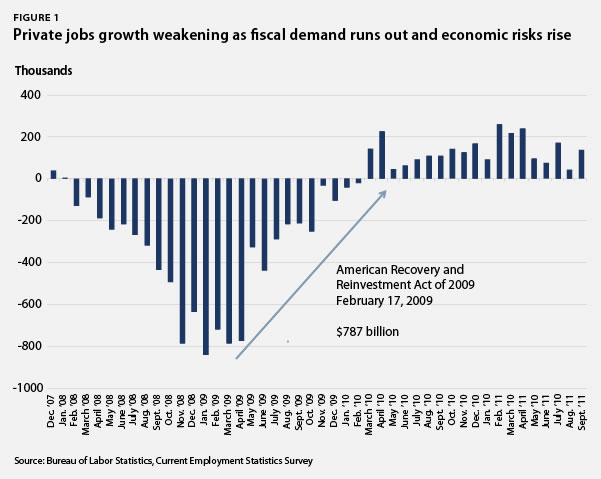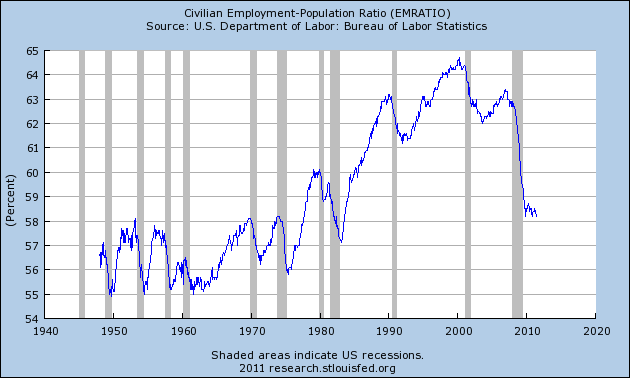|
JUNE
2011 UNEMPLOYMENT DATA*
(U.S.
BUREAU OF LABOR STATISTICS)
OFFICIAL UNEMPLOYMENT:
9.2%
A year earlier, the number of unemployed
persons was 14.6
million, and the jobless rate was 9.5 percent. [BLS]
| White |
8.1% |
| African
American |
16.2% |
| Hispanic |
11.6% |
| Asian** |
6.8% |
| Persons with a disability ** |
16.9% |
| Men
20 years and over |
9.1% |
| Women
20 years and over |
8.0% |
| Teens
(16-19 years) |
24.5% |
| Black
teens |
39.9% |
| Officially
unemployed |
14.1
million |
HIDDEN UNEMPLOYMENT
| Working
part-time because can't find a full-time job: |
8.6
million |
| People
who want jobs but are
not looking so are
not counted in official statistics (of which about 2.7 million**
searched for work during the prior 12 months and were available
for work during the reference week.) |
6.5
million |
|
Total:
29.2 million (18.3% of the labor force)
|
Source: http://www.bls.gov/news.release/pdf/empsit.pdf
**Not seasonally adjusted.
*See Uncommon Sense #4 for an explanation
of the unemployment measures.
In addition, millions
more were working full-time, year-round, yet earned less than
the official poverty level for a family of four. In 2009, the
latest year available, that number was 16.3 million, 16.4 percent
of full-time, full-year workers (estimated from Current
Population Survey, Bur. of the Census, 2010).
In April, 2011,
the latest month available, the number of job openings was 3.0 million,
"little changed from 3.1 million in March. After increasing
in February, job openings have been flat. Job openings have been
around 3.0 million for three consecutive months; the last three-month
period with levels this high was September—November 2008.
The number of job openings was 549,000 higher than at the end of
the recession in June 2009 (as designated by the National Bureau
of Economic Research) but remains well below the 4.4 million openings
when the recession began in December 2007." Job
Openings and Labor Turnover Estimates, June 7, 2011.+
Thus there are now more than 9 job-wanters for each available job.

Source: http://www.americanprogress.org/issues/labor/news/2011/01/07/8849/employment-growth-continues-but-too-slowly-to-secure-recovery/
Employment-population
ratio 1/1948 to 5/2011

http://research.stlouisfed.org/fred2/series/EMRATIO
Mass
layoffs:
5/11 first quarter 2011 Employers initiated 1,397
mass layoff events in the first quarter of 2011 that resulted
in the separation of 190,895 workers from their jobs for at least
31 days, the U.S. Bureau of Labor Statistics reported today. Extended
mass layoff events and separations have decreased over the year
for six consecutive quarters. .... Forty-nine percent of employers
expected to recall at least some laid-off workers, the highest
first quarter percentage since 2005 and up from 38 percent in
2010.
Mass
layoffs: Review
of 2010 BLS, 2/11/11
For all of 2010, employers reported 7,158 extended mass layoff
actions, affecting 1,213,638 workers. Compared to 2009, the number
of events decreased by 39 percent and the number of separations
decreased by 42 percent, the first over-the-year decline for both
measures since 2005. The annual average national unemployment
rate increased from 9.3 percent in 2009 to 9.6 percent in 2010,
and private nonfarm payroll employment decreased by 0.8 percent,
or 914,000.
Industry Distribution of Extended Layoffs
In the private nonfarm economy, manufacturing reported the largest
number of separations, despite reaching a program low in 2010
(with annual data available back to 1996). Construction had the
next highest number of separations. Educational services reported
program highs in both layoff events and separations in 2010.
....
+
"The number of job openings in April
(not seasonally adjusted) increased from 12 months earlier for
total private, four industries, and in the Midwest region. The
level decreased over the year for other services, government,
and federal government. Over-the-year comparisons for federal
government in April are impacted, in part, by the large number
of job openings for temporary workers to conduct the 2010 Census."
|

